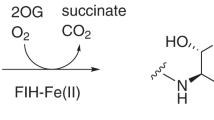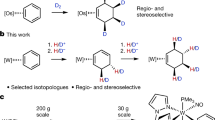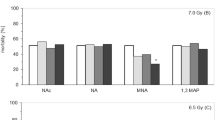Abstract
SEVERAL derivatives of hydroxylamine1, including hydroxyurethane, N-methylhydroxylamine and hydroxy-aminoacetic acid, cause chromosome abnormalities in mouse embryo and Chinese hamster cells similar to those induced by hydroxylamine2. Similar chromosomal abnormalities are also induced in anaphase and metaphase chromosomes of the root tips of Vicia faba by hydroxylamine, methyl-, ethyl-, n-propyl-, and n-butyl-N-hydroxycarbamates (S. H. Revell and K. S. Peggie, personal communication). Urethane appears to produce many radiomimetic effects through the metabolite N-hydroxyurethane to which it is converted by animals3. Although urea and urethane are inactive in these systems, hydroxy-urea1 and N-hydroxyurethane3 are active; hydroxyurea is also an anti-tumour agent which is active against the L1210 leukæmia in mice4. It has been proposed1,3,5,6 that these hydroxylamino derivatives may exercise their effects by a common chemical mechanism involving the production of nitroxyl or hydroxylamine in vivo.
This is a preview of subscription content, access via your institution
Access options
Subscribe to this journal
Receive 51 print issues and online access
$199.00 per year
only $3.90 per issue
Buy this article
- Purchase on Springer Link
- Instant access to full article PDF
Prices may be subject to local taxes which are calculated during checkout
Similar content being viewed by others
References
Borenfreund, E., Krim, M., and Bendich, A., J. Nat. Cancer Inst., 32, 667 (1964).
Somers, C. E., and Hsu, T. C., Proc. U.S. Nat. Acad. Sci., 48, 937 (1962).
Boyland, E., Nery, R., Peggie, K. S., and Williams, K., Biochem. J., 89, 113P (1963).
Sterns, B., Losee, K. A., and Bernstein, J., J. Med. Chem., 6, 201 (1963).
Fishbein, W. N., and Carbone, P. P., Science, 142, 1069 (1963).
Boyland, E., and Nery, R., Biochem. J. (in the press).
Author information
Authors and Affiliations
Rights and permissions
About this article
Cite this article
BOYLAND, E., NERY, R. Dihydroxyurea. Nature 203, 1379–1380 (1964). https://doi.org/10.1038/2031379a0
Issue Date:
DOI: https://doi.org/10.1038/2031379a0
This article is cited by
-
Synthesis of dihydroxyurea and its application to the U/Pu split in the PUREX process
Journal of Radioanalytical and Nuclear Chemistry (2009)
-
Inhibition of Shope Fibroma Virus With N-Hydroxyurethane and Related Compounds
Nature (1965)
Comments
By submitting a comment you agree to abide by our Terms and Community Guidelines. If you find something abusive or that does not comply with our terms or guidelines please flag it as inappropriate.



